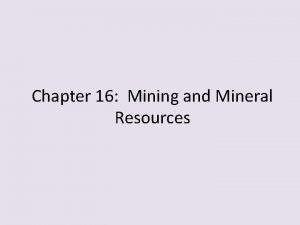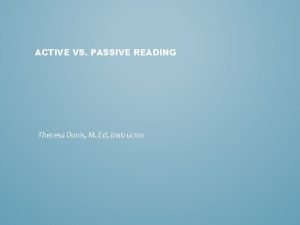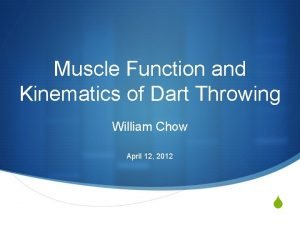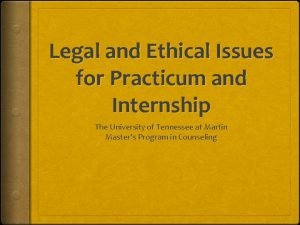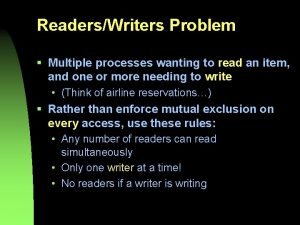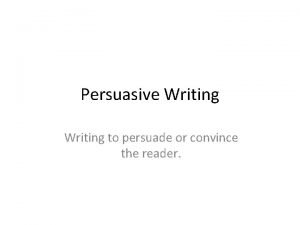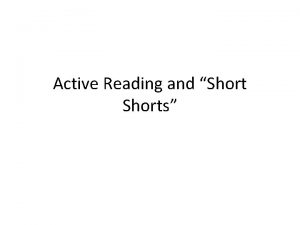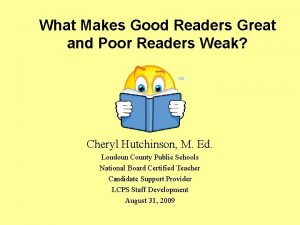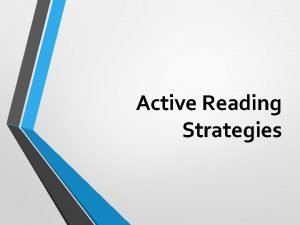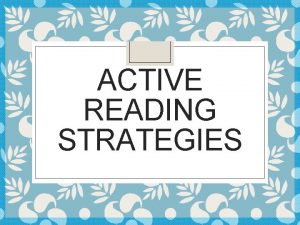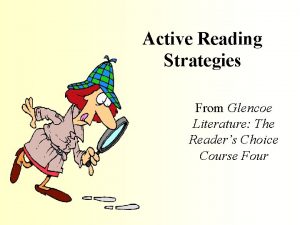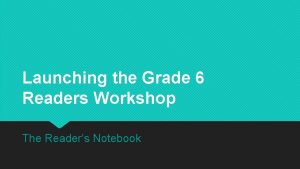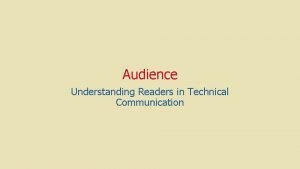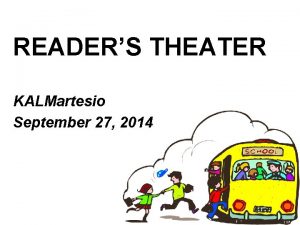Active Reading and Study Active readers are involved



















- Slides: 19

Active Reading and Study Active readers are involved in what they are reading.

ACTIVE READING PEANUTS: ©United Feature Syndicate, Inc. • The light-haired girl in the cartoon is the opposite of an active reader. • She is a passive reader, whose mind does not pay attention to what she reads.

ACTIVE READING To read actively: • Ask yourself, “What is the point? ” and “What is the support for the point? ” • Pay close attention to titles and other headings, and also mark off definitions, examples, and enumerations.

ACTIVE READING It is important to write out answers to the two basic questions, “What is the point? ” and “What is the support for the point? ” The very act of writing helps an active reader study and master and remember the material.

ACTIVE READING Read this paragraph, asking yourself, “What is the author’s point, and how does he support his point? ” Humanistic psychologist Carl Rogers believed that people are basically good and are endowed with tendencies to fulfill their potential. Each of us is like an acorn, primed for growth and fulfillment, unless thwarted by an environment that inhibits growth. Rogers theorized that a growthpromoting climate for people required three conditions. The first of those conditions is genuineness. According to Rogers, people nurture our growth by being genuine—by dropping false faces and being open with their own feelings. The secondition, said Rogers, is by offering “unconditional positive regard”—an attitude of total acceptance toward another person. We sometimes enjoy this gratifying experience in a good marriage, a close family, or an intimate friendship in which we no longer feel a need to explain ourselves and are free to be spontaneous without fear of losing another’s esteem. Finally, Rogers said that people nurture growth by being empathic—by nonjudgmentally reflecting our feelings and meanings. “Rarely do we listen with real understanding, true empathy, ” he said. “Yet listening, of this very special kind, is one of the most potent forces for change that I know. ”

Humanistic psychologist Carl Rogers believed that people are basically good and are endowed with tendencies to fulfill their potential. Each of us is like an acorn, primed for growth and fulfillment, unless thwarted by an environment that inhibits growth. Rogers theorized that a growthpromoting climate for people required three conditions. The first of those conditions is genuineness. According to Rogers, people nurture our growth by being genuine—by dropping false faces and being open with their own feelings. The secondition, said Rogers, is by offering “unconditional positive regard”—an attitude of total acceptance toward another person. We sometimes enjoy this gratifying experience in a good marriage, a close family, or an intimate friendship in which we no longer feel a need to explain ourselves and are free to be spontaneous without fear of losing another’s esteem. Finally, Rogers said that people nurture growth by being empathic—by nonjudgmentally reflecting our feelings and meanings. “Rarely do we listen with real understanding, true empathy, ” he said. “Yet listening, of this very special kind, is one of the most potent forces for change that I know. ”

ACTIVE READING If you were reading this selection in a textbook, this is how you might mark off the material: 1 2 3 Humanistic psychologist Carl Rogers believed that people are basically good and are endowed with tendencies to fulfill their potential. Each of us is like an acorn, primed for growth and fulfillment, unless thwarted by an environment that inhibits growth. Rogers theorized that a growthpromoting climate for people required three conditions. The first of those conditions is genuineness. According to Rogers, people nurture our growth by being genuine—by dropping false faces and being open with their own feelings. The secondition, said Rogers, is by offering “unconditional positive regard”—an attitude of total acceptance toward another person. We sometimes enjoy this gratifying experience in a good marriage, a close family, or an intimate friendship in which we no longer feel a need to explain ourselves and are free to be spontaneous without fear of losing another’s esteem. Finally, Rogers said that people nurture growth by being empathic—by nonjudgmentally reflecting our feelings and meanings. “Rarely do we listen with real understanding, true empathy, ” he said. “Yet listening, of this very special kind, is one of the most potent forces for change that I know. ” The next step is to write down the point and the support. • What would you write down as the point of this selection? • What would you write down as the support?

ACTIVE READING Below is what you might write after asking yourself, “What is the author’s point, and how does he support his point? ” 1 2 3 Humanistic psychologist Carl Rogers believed that people are basically good and are endowed with tendencies to fulfill their potential. Each of us is like an acorn, primed for growth and fulfillment, unless thwarted by an environment that inhibits growth. Rogers theorized that a growthpromoting climate for people required three conditions. The first of those conditions is genuineness. According to Rogers, people nurture our growth by being genuine—by dropping false faces and being open with their own feelings. The secondition, said Rogers, is by offering “unconditional positive regard”—an attitude of total acceptance toward another person. We sometimes enjoy this gratifying experience in a good marriage, a close family, or an intimate friendship in which we no longer feel a need to explain ourselves and are free to be spontaneous without fear of losing another’s esteem. Finally, Rogers said that people nurture growth by being empathic—by nonjudgmentally reflecting our feelings and meanings. “Rarely do we listen with real understanding, true empathy, ” he said. “Yet listening, of this very special kind, is one of the most potent forces for change that I know. ” Point: According to Carl Rogers, a growth-promoting climate for people requires three conditions. Support: 1. Genuineness—dropping false faces and being open with one’s feelings 2. Unconditional positive regard—total acceptance of another person 3. Being empathic—nonjudgmentally reflecting our feelings and meanings

ACTIVE READING 1 2 3 Humanistic psychologist Carl Rogers believed that people are basically good and are endowed with tendencies to fulfill their potential. Each of us is like an acorn, primed for growth and fulfillment, unless thwarted by an environment that inhibits growth. Rogers theorized that a growthpromoting climate for people required three conditions. The first of those conditions is genuineness. According to Rogers, people nurture our growth by being genuine—by dropping false faces and being open with their own feelings. The secondition, said Rogers, is by offering “unconditional positive regard”—an attitude of total acceptance toward another person. We sometimes enjoy this gratifying experience in a good marriage, a close family, or an intimate friendship in which we no longer feel a need to explain ourselves and are free to be spontaneous without fear of losing another’s esteem. Finally, Rogers said that people nurture growth by being empathic—by nonjudgmentally reflecting our feelings and meanings. “Rarely do we listen with real understanding, true empathy, ” he said. “Yet listening, of this very special kind, is one of the most potent forces for change that I know. ” Notice that the main idea is signaled by the list words three conditions. And the supporting details are clearly marked by the addition words first, second, and Finally.

A TEXTBOOK STUDY SYSTEM The previous four slides have shown you a basic study system that really works: 1 Read the material, looking for the main points and supporting details. 2 Take written notes on the main points and supporting details.

A TEXTBOOK STUDY SYSTEM Taking notes on a subject can help in thinking about and understanding the subject. Writing is thinking.

A TEXTBOOK STUDY SYSTEM A Detailed Study System: PRWR There a variety of similar textbook study systems. One is PRWR: 1 Preview 2 Read 3 Write 4 Recite

A TEXTBOOK STUDY SYSTEM A Detailed Study System: PRWR 1 Preview the chapter to get a general overview and “a lay of the land” before you start reading. • Note the title. • Quickly read the first and last paragraphs of the chapter.

A TEXTBOOK STUDY SYSTEM A Detailed Study System: PRWR 2 Read and mark what seem to be the important ideas in the chapter. • In particular, mark definitions, examples, and enumerations (major lists of items).

A TEXTBOOK STUDY SYSTEM A Detailed Study System: PRWR 3 Write (or type into your computer) study notes on the chapter. • Actual writing and notetaking is a key to successful learning. • Organize your notes as a rough outline that shows relationships between ideas.

A TEXTBOOK STUDY SYSTEM A Detailed Study System: PRWR 4 Recite your study notes until you can say them to yourself without looking at them. • Repeated self-testing is the key to effective learning. • It is impossible to be a passive learner if you continue this strategy of repeated selftesting.

REVIEW • Active readers think and ask questions as they read. Active readers ask, “What is the point? ” and “What is the support for the point? ” Active readers also pay close attention to titles and other headings, as well as definitions, examples, and enumerations. • Active readers often have a pen in hand as they read so they can mark off what seem to be the important ideas. • Active readers often use a reading study system. In a nutshell, they preview a selection first; then, they read and mark off what seem to be the important ideas; next, they take written notes on that material; and finally, they recite their notes until they can remember them.

That’s All!

Iris Strunc strunci@nwfsc. edu
 Antigentest åre
Antigentest åre Slidetodoc.com
Slidetodoc.com While reading activities
While reading activities To persuade entertain or inform
To persuade entertain or inform Aims and objectives of reading
Aims and objectives of reading Intensive reading characteristics
Intensive reading characteristics Real definition of extensive reading
Real definition of extensive reading Extensive reading
Extensive reading What is reading
What is reading Feeding the world active reading
Feeding the world active reading Active process of discovery
Active process of discovery Mineral exploration and mining active reading
Mineral exploration and mining active reading What is passive reading
What is passive reading Boolean operators
Boolean operators Membrane structures that function in active transport
Membrane structures that function in active transport Anatomy of throwing a dart
Anatomy of throwing a dart Ethical and legal issues involved in practicum
Ethical and legal issues involved in practicum Steps involved in developing and running a local applet
Steps involved in developing and running a local applet Readers writers problem
Readers writers problem Persuade the reader
Persuade the reader











